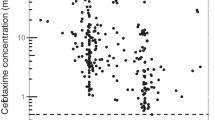Abstract
Differences in pharmacokinetic data of aminoglycosides, ceftazidime and ceftriaxone between intensive care patients and volunteers or patients who are less severely ill, are described. Similar differences are observed for midazolam. In severely ill patients with normal renal function a wide interpatient variability of aminoglycoside half-life (t1/2) and increased distribution volume (Vd) are observed. This results in inadequate serum levels. A pharmacokinetic approach of drug dosing, based on serum concentrations in individual patients, is advised. For ceftazidime and ceftriaxone similar changes of t1/2 and Vd are observed. Since protein binding is frequently reduced in severely ill patients, the influence of altered binding of highly bound drugs on Vd and drug clearance is discussed. As both may be increased by reduced protein binding, the change of t1/2 to be expected is unpredictable. Dosing regimens should be based on pharmacokinetic data derived from patients whose severity of disease is comparable to that of the patients to be treated.
Similar content being viewed by others
References
Byatt CM, Lewis LD, Dawling S, Cochrane GM (1984) Accumulation of midazolam after repeated dosage in patients receiving mechanical ventilation in an intensive care unit. Br Med J 289:799–800
Summer WR, Michael JR, Lipsky JJ (1983) Initial aminoglycoside levels in the critically ill. Crit Care Med 11:948–950
Niemiec PW, Allo MD, Miller CF (1987) Effect of altered volume of distribution on aminoglycoside levels in patients in surgical intensive care. Arch Surg 122:207–212
Driscoll DF, McMahon M, Blackburn GL, Bistrian BR (1988) Phenytoin toxicity in a critically ill, hypoalbuminemic patient with normal serum drug concentrations. Crit Care Med 16:1248–1249
Joos B, Luethy R, Muehlen E, Siegenthaler W (1984) Variability of ceftriaxone pharmacokinetics in hospitalized patients with severe infections. Am J Med [Suppl 4C] 77:59–62
Kaye D, Levison ME, Labovitz ED (1974) The unpredictability of serum concentrations of gentamicin: pharmacokinetics of gentamicin in patients with normal and abnormal renal function. J Infect Dis 130:150–154
Zaske DE, Cipolle RJ, Strate RG (1980) Genetamicin dosage requirements: wide interpatient variations in 242 surgery patients with normal renal function. Surgery 87:164–169
Zaske DE, Cipolle RJ, Strate RG, Dickes WF (1981) Increased gentamicin dosage requirements: rapid elimination in 249 gynecology patients. Am J Obstet Gynecol 139:896–900
Dasta JF, Armstrong DK (1988) Variability in aminoglycoside pharmacokinetics in critically ill surgical patients. Crit Care Med 16:327–330
Van Dalen R, Vree TB, Baars AM, Termond E (1986) Dosage adjustment for ceftazidime in patients with impaired renal function. Eur J Clin Pharmacol 30:597–605
Harding SM, Monro AJ, Thornton JE, Ayrton J, Hogg MIJ (1981) The comparative pharmacokinetics of ceftazidime and cefotaxime in healthy volunteers. J Antimicrob Chemother [Suppl B] 8:263–272
Sommers D, Walters L, van Wyk M, Harding SM, Paton AM, Ayrton J (1983) Pharmacokinetics of ceftazidime in male and female volunteers. Antimicrob Agents Chemother 23:892–896
Van Dalen R, Vree TB, Baars AM (1987) Influence of protein binding and severity of illness on renal elimination of four cephalosporin drugs in intensive care patients. Pharm Weekbl (Sci) 9:98–103
Patel IH, Chen S, Parsonnet M et al. (1981) Pharmacokinetics of ceftriaxone in humans. Antimicrob Agents Chemother 20:634–641
Patel IH, Kaplan SA (1984) Pharmacokinetic profile of ceftriaxone in man. Am J Med [Suppl 4C] 77:17–25
Dundee JW, Collier PS, Carlisle RJT, Harper KW (1986) Prolonged midazolam elimination half-life. Br J Clin Pharmacol 21:425–429
Dirksen MSC, Vree TB, Driessen JJ (1987) Clinical pharmacokinetics of long-term infusion of midazolam in critically ill patients—Preliminary results. Anaesth Intensive Care 15:440–444
Shelly MP, Mendel L, Park GR (1987) Failure of critically ill patients to metabolise midazolam. Anaesthesia 42:619–626
Townsend PL, Fink MP, Stein KL, Murphy SG (1989) Aminoglycoside pharmacokinetics: dosage requirements and nephrotoxicity in trauma patients. Crit Care Med 17:154–157
Vree TB, Shimoda M, Driessen JJ et al. (1989) Decreased plasma albumin concentration results in increased volume of distribution and decreased elimination of midazolam in intensive care patients. Clin Pharmacol Ther 46:537–544
Rowland M (1984) Protein binding and drug clearance. Clin Pharmacokinet [Suppl 1] 9:10–17
Wise R (1986) The clinical relevance of protein binding and tissue concentrations in antimicrobial therapy. Clin Pharmacokinet 11:470–482
Craig WA, Welling PG (1977) Protein binding of antimicrobials: clinical pharmacokinetic and therapeutic implications. Clin Pharmacokinet 2:252–268
Tillement JP, Lhoste F, Giudicelli JF (1978) Diseases and drug protein binding. Clin Pharmacokinet 3:144–154
Wedlund PJ, Branch RA (1983) Adjustment of medications in liver failure. In: Chernow B, Lake CR (eds) The pharmacologic approach to the critically ill patient. Williams and Wilkins, Baltimore, pp 84–114
Wilkins RG, Faragher EB (1983) Acute renal failure in an intensive care unit: incidence, prediction and outcome. Anaesthesia 38:628–634
Menashe PI, Ross SA, Gottlieb JE (1988) Acquired renal insufficiency in critically ill patients. Crit Care Med 16:1106–1109
Maher JF (1983) Adjustment of medications in renal failure. In: Chernow B, Lake CR (eds) The pharmacologic approach to the critically ill patient. Williams and Wilkins, Baltimore, pp 65–83
Chelluri L, Jastremski MS (1987) Inadequacy of standard aminoglycoside loading doses in acutely ill patients. Crit Care Med 15:1143–1145
Moore RD, Lietman PS, Smith CR (1987) Clinical response to aminoglycoside therapy: Importance of the ratio of peak concentration to minimal inhibitory concentration. J Infect Dis 155:93–99
Moore RD, Smith CR, Lietman PS (1984) The association of aminoglycoside plasma levels with mortality in patients with gramnegative bacteremia. J Infect Dis 149:443–448
Franson TR, Quebbeman EJ, Whipple J et al. (1988) Prospective comparison of traditional and pharmacokinetic aminoglycoside dosing methods. Crit Care Med 16:840–843
Hickling K, Begg E, Moore ML (1989) A prospective randomised trial comparing individualised pharmacokinetic dosage prediction for aminoglycosides with prediction based on estimated creatinine clearance in critically ill patients. Intensive Care Med 15:233–237
Author information
Authors and Affiliations
Rights and permissions
About this article
Cite this article
van Dalen, R., Vree, T.B. Pharmacokinetics of antibiotics in critically ill patients. Intensive Care Med 16 (Suppl 3), S235–S238 (1990). https://doi.org/10.1007/BF01709707
Issue Date:
DOI: https://doi.org/10.1007/BF01709707




